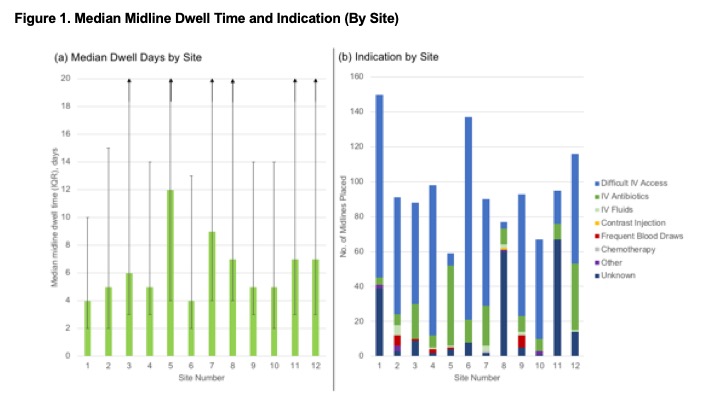Background: Midline vascular catheters are gaining popularity in clinical practice. However, patterns of use and outcomes related to these devices are not well known.
Methods: Trained abstractors collected detailed patient-, device- and outcome data from medical records of hospitalized patients that received midline catheters from 12 hospitals participating in the Michigan Hospital Medicine Safety (HMS) consortium. Device characteristics, patterns of use and outcomes were assessed at device removal or 30-days, whichever occurred first. Rates of major (upper-extremity deep vein thrombosis [DVT], bloodstream infection [BSI] and catheter occlusion) and minor complications (infiltration, leaking and dislodgement) were assessed. Chi-squared tests were used to examine hospital-level differences in rates of midline use and complications. Variation in rates of midline use by patient and hospital factors was also assessed using Pearson correlation.
Results: Complete data on 1,161 midlines placed between January 1, 2017 to March 31, 2018 were available. Most (70.8%) midlines were placed in general ward settings for difficult intravenous access (61.4%). The median dwell time of midlines across hospitals was 6 days; almost half (49%) were removed within 5 days of insertion. A major or minor complication occurred in 9.7% of midlines with minor complications such as dislodgement and infiltration accounting for 71% of all adverse events. Single lumen midline catheters had lower rates of complications than multi-lumen devices (p=0.01).While rates of major complications including occlusion, DVT and BSI were low (2,2%, 1.4%, and 0.3%, respectively), they were just as likely to lead to midline removal as minor complications (53.8% vs. 66.7%, p=0.21). Across hospitals, absolute volume of midline use varied from 100 to 1,837 devices with corresponding utilization rates of 0.97% to 12.92% (p<0.001). Variation in rates of midline use was not explained by severity of patient illness or by hospital size (r=-0.20 and r=-0.37 respectively).
Conclusions: Patterns of midline use and outcomes vary widely across hospitals. Although rates of major complications are low, device removal as a result of adverse events is common. Efforts to improve midline catheter use and outcomes appear necessary.

